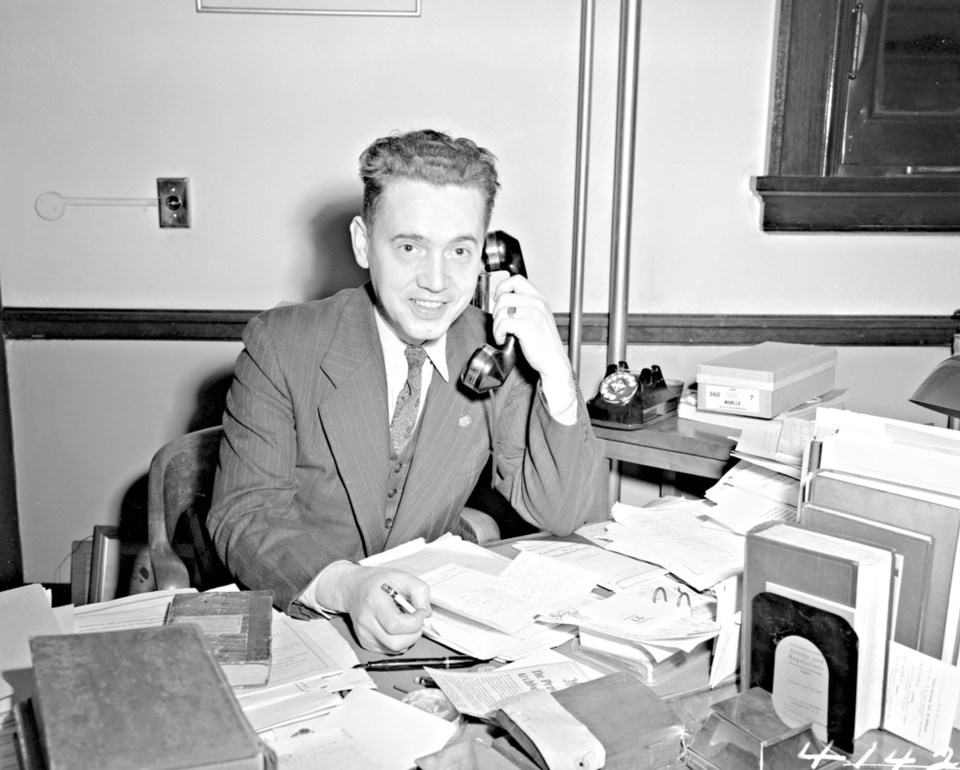I recently became president of the Friends of the British Columbia Archives. It’s a non-profit society that aims to foster awareness and appreciation of the B.C. Archives and the documentary heritage of our province.
But my connection with the B.C. Archives goes back many years — back to high school, in fact.
That is when I interviewed Willard Ireland, the provincial archivist, for a future careers assignment. I can’t explain my interest in archivy but Ireland encouraged me to pursue it.
He suggested that a degree in history might be helpful, and so it was. At the University of Victoria I took a course on B.C. history from Patricia Roy. A course requirement was to write a research paper using primary material in the Provincial Archives.
I was also hired as a student guide at the Provincial Museum, working in the summer months and on weekends. Guides were not expected to provide detailed information on the exhibits. Rather, we directed visitors to amenities in the building; explained the significance of the handsome wood panels in the second and third floor lounges (one lounge featured commercial species, the other non-commercial trees); and we politely asked folks not to pull at the curtain of rain that graced the entrance to the Orientation Hall, now called Clifford Carl Hall.
We had lots of time, however, to study the exhibits and to chat with curators, technicians, and designers. Like many visitors, I marvelled at the creativity and expertise of the staff. It was evident that the Provincial Museum was a special place of knowledge.
So, too, was the Provincial Archives of British Columbia, as I discovered when I joined the staff as an archivist in the 1980s, after a stint as a sessional instructor at the University of Victoria. I worked in the Manuscripts and Government Records division, which focused on textual records. Half a dozen archivists were part of this division and each of them had expertise in different historical fields, such as transportation, health, mining and forestry.
There were also divisions devoted to oral history, radio recordings, and films; historical photographs; paintings and drawings; library books and journals. The archives staff included highly skilled conservators, photographers, and editors. These colleagues comprised a professional knowledge community with expertise in all aspects of B.C. history.
Their expertise was freely available to the researchers who sent letters of enquiry or visited the Reference Room in person. It was shared through publications such as the Sound Heritage monographs. Comparable and complimentary expertise on the natural and human history of British Columbia was available from the museum curators whose offices and collections were in the nearby Fannin Tower.
I benefited from their expertise when I resumed teaching at UVic and joined the History Department at Vancouver Island University in Nanaimo. My friends and former colleagues from the archives and museum cheerfully and generously shared their knowledge when I asked them for guest lectures in B.C. history and public history courses.
The archivists and curators who spoke to my classes over the years also provided guidance, motivation, and encouragement to students who wanted to pursue careers in archives, museums, and libraries.
I retired from teaching a few years ago, but I’m still involved with historical research and depend on the resources of the B.C. Archives. The resources are increasingly available online, but I like the physical space that is the Reference Room.
As a historian, I enjoy visiting the Old Town Gallery on the third floor of the Exhibition Hall, and marvel at the way the streetscape was created. I’m impressed at the knowledge and expertise of curators and archivists and other staff members who maintain and interpret the collections today. And I appreciate the contributions that staff members from the Royal B.C. Museum and B.C. Archives have made to their professions via organizations such as the British Columbia Museums Association and the Association of Canadian Archivists.
One of the objectives of the Friends of the B.C. Archives is to promote “understanding, communication and co-operation between the British Columbia Archives and the people of British Columbia.” By extension, we seek to foster connections between the public and the corporate entity that now encompasses the archives, the Royal British Columbia Museum.
We promote our objectives through a newsletter, website, and social media. We also sponsor public presentations where guest speakers provide illustrated talks on topics relating to B.C. history. We’re especially keen on presenters who have used material from the collections of the B.C. Archives.
The presentations are free to members and $5 for non-members. (Annual dues for individual members are only $20; for seniors and students, $15.) But presentations that follow our annual general meeting are free to everyone, since we’re eager to showcase the high calibre of our programs and enroll new members.
This year, our annual general meeting will be held at 2 p.m. Sunday, Oct. 30, in the newly-refurbished Newcombe Auditorium. Guest speaker Glen Mofford will talk about the research behind his new book, Aqua Vitae: The saloons and hotel bars of Victoria, 1851-1917. The book’s cover features a historical image from the B.C. Archives, and many more are found inside.
After the presentation, I’m going to propose an anniversary toast to the Royal B.C. Museum and B.C. Archives. I’m also going to toast Willard Ireland, who introduced me to this remarkable place of historical knowledge. Cheers!
Patrick A. Dunae was born in Victoria and attended Mount View Secondary School. He is an adjunct associate professor in the History Department at the University of Victoria and professor emeritus at Vancouver Island University.
